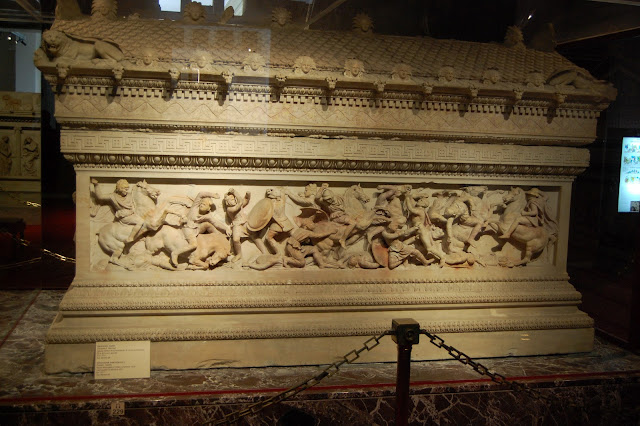The biggest mistake we made while in Istanbul was trying to tour the Archaeological Museum after an already full day of sightseeing. Oh man, we were so tired. After about half an hour in the museum we realized that it would really take a full day, if not two, to take everything in so at that point we decided to just seek out the highlights. I enjoyed walking through the sculpture in the courtyard where I spied this Medusa head that wasn't surrounded by tourists (like at the cistern).
The most well known piece in the museum is the Alexander Sarcophagus. It was found at the necropolis Sidon in 1887, however it does not belong to Alexander the Great but instead to the king of Sidon, Abdalonymu. As you can see it is in astonishing condition including the sections of red paint that remain.
Next, we spotted a portion of the chains that were used during the 1453 siege by the Ottoman Empire. The chain was placed at the mouth of the harbor at the Golden Horn to prevent the passage of enemy vessels. One end was attached at the Kastellion in Galata and it stretched across the water and was attached to the Tower of Eugenius in the modern suburb of Sarayburnu. In the end the chains held up so the city was eventually conquered by ground attack.
Finally, we spotted a head of a serpent that originally topped the Serpent Column. This ancient bronze column currently stands in the Hippodrome in Istanbul (as seen below) but it was originally an ancient Greek sacrificial tripod that stood at Delphi. It was made in 478 BC to commemorate the Greeks who fought and defeated the Persian Empire in the Battle of Plataea. It was taken to Constantinople by Constantine the Great in 324 AD. The story gets a bit fuzzy after its move to Constantinople but legend has it that a drunken Polish nobleman knocked the serpents head off of the column around 1700 and what is known to remain is in the Archaeological Museum.
The most well known piece in the museum is the Alexander Sarcophagus. It was found at the necropolis Sidon in 1887, however it does not belong to Alexander the Great but instead to the king of Sidon, Abdalonymu. As you can see it is in astonishing condition including the sections of red paint that remain.
Next, we spotted a portion of the chains that were used during the 1453 siege by the Ottoman Empire. The chain was placed at the mouth of the harbor at the Golden Horn to prevent the passage of enemy vessels. One end was attached at the Kastellion in Galata and it stretched across the water and was attached to the Tower of Eugenius in the modern suburb of Sarayburnu. In the end the chains held up so the city was eventually conquered by ground attack.
Finally, we spotted a head of a serpent that originally topped the Serpent Column. This ancient bronze column currently stands in the Hippodrome in Istanbul (as seen below) but it was originally an ancient Greek sacrificial tripod that stood at Delphi. It was made in 478 BC to commemorate the Greeks who fought and defeated the Persian Empire in the Battle of Plataea. It was taken to Constantinople by Constantine the Great in 324 AD. The story gets a bit fuzzy after its move to Constantinople but legend has it that a drunken Polish nobleman knocked the serpents head off of the column around 1700 and what is known to remain is in the Archaeological Museum.

























































